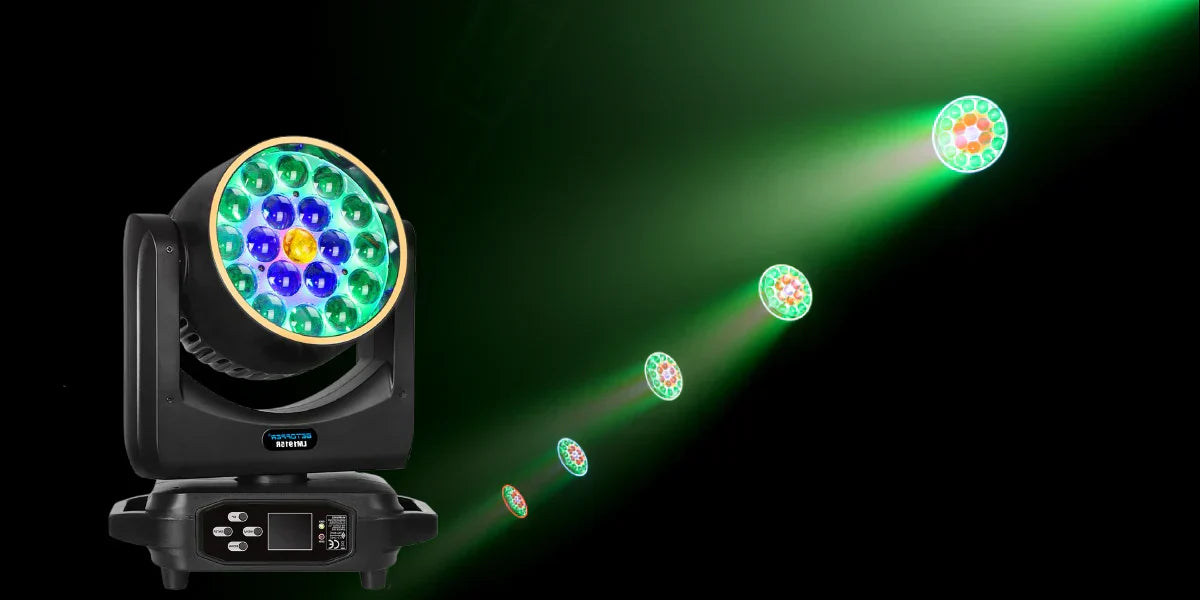予算を抑えながら、しっかりとしたDJ照明セットアップを構築する方法をご紹介します。この2025年版ガイドでは、照明器具の種類、スマートなセットアップのヒント、そしてモバイルDJや初心者DJ向けの予算に優しい戦略を解説します。
DJ照明セットアップに本当に必要なもの
優れたDJ照明セットアップは、照明器具の数ではなく、各照明器具が空間の明瞭性、動き、そして観客のエンゲージメントにどれだけ効果的に貢献するかによって決まります。予算に関わらず、機能的なシステムは3種類のコア照明器具で構成され、それぞれが視覚的な構成において明確な役割を果たします。
1.ウォッシュライト – アンビエントカバレッジとカラーファンデーション
ウォッシュライトはステージ全体の色調を左右します。幅広く柔らかなエッジのビームを放ち、空間を色彩で満たし、スムーズなトランジションと視覚的な統一感を生み出します。パフォーマーの頭上または背後に設置されたウォッシュライトは、舞台全体の雰囲気を演出し、ムードの移り変わりをサポートするために不可欠です。
例えば、コンパクトなセットアップでは、ズーム可能なLEDウォッシュムーバー LM0740 貴重な柔軟性を提供し、リグのスペースが限られている場合にカバレッジと焦点効果の両方を提供します。
2.ビームライト – 動き、方向、リズム
ビーム照明は、狭角で高輝度の光を投射します。ヘイズと組み合わせることで、空間に躍動感を与える、明瞭な光の筋を生み出します。主な役割は、特にパーカッシブな要素やハイテンポな要素を含むジャンルにおいて、リズムと方向性を強調することです。ビーム照明は、演奏者の頭上または背後を横切るように高所に設置すると最も効果的です。
例えば、150WのLEDビームムーバー(LB150電動プリズムと DMX コントロールを備えた ) は、中規模環境でエネルギーと精度の両方を実現します。
3. PARライト – 固定焦点と前面照明
PARライトは、DJブース、バックドロップ、フロントフィルなどの主要な要素を、クリーンかつ均一に照射する固定式の照明器具です。シンプルなデザインですが、映像の鮮明さにおいて重要な役割を果たします。特に混色照明や霧が濃い環境下でも、焦点を十分に照らすことでパフォーマーの視認性を確保できます。
例えば、高CRI PARライト LPC1818 結婚式や放送環境など、色の忠実度と顔の照明が重要となるイベントに適しています。
4. エフェクトフィクスチャー – アクセントツール、コアカバレッジではありません
ストロボ、ピクセルバー、レーザー照明器具は、用途に応じて控えめに使用する必要があります。これらの要素は、音楽のブレイクを強調したり、ドラマチックな瞬間を際立たせたりするのに最適です。基礎となるウォッシュやビームレイヤーがないと、エフェクトのみのセットアップは断片的で視覚的にアンバランスな印象を与えがちです。

よくある予算の落とし穴とその回避方法
主要な照明器具の種類を理解することは、ほんの第一歩に過ぎません。予算を最大限に活用するには、何をすべきでないかを理解することも同様に重要です。多くのDJは、特に初めて照明セットを購入する際に、間違った優先順位にこだわったり、重要な技術的詳細を見落としたりしがちです。その結果、バランスが崩れたり、パフォーマンスが不安定になったり、ライブイベントのニーズを満たせなくなったりするリグになってしまうことがよくあります。
予算に優しい照明システムを構築するときに避けるべき最も一般的な間違いは次のとおりです。
- 基礎を築く前に効果に過剰投資する
ストロボ、レーザー、ピクセルバーなどで機材をいっぱいに詰め込みたくなるかもしれません。しかし、ウォッシュライトやビームライトといったベースレイヤーがないと、これらのエフェクトは構造が欠け、ばらばらに見えてしまいます。まずはコアとなる照明を優先すべきです。エフェクトはショーを支えるものであり、邪魔になるものではありません。
- ワット数と出力の混同
明るさはワット数だけでは決まりません。真のパフォーマンスは、レンズの品質、ビーム角度、LEDの効率によって決まります。最適化された光学系を備えた150Wのビームライト(
- 「DMX互換」をフルコントロールと誤読する
DMX機能を搭載しているからといって、必ずしも柔軟性が高いとは限りません。多くの低価格照明はチャンネルマッピングが制限されていたり不安定だったりするため、効果的な制御が困難です。購入前に必ず詳細なマニュアルとチャンネルチャートをご確認ください。
- サウンド起動モードに完全に依存
サウンド・トゥ・ライトモードはプラグアンドプレイですが、制御機能が限られています。これらのモードは通常、音楽の構成ではなく音量の急上昇に反応するため、照明が不規則になったり、リズムがずれたりすることがあります。基本的なDMXプログラミングやアプリによる制御でも、よりタイトなショーを実現できます。
- 配置戦略なしでの購入
計画なしに複数の照明器具を購入すると、設置が雑然としてしまいます。色温度の不一致、取り付け位置の不統一、明るさのムラなどは、どれもまとまりのない印象を与えます。それぞれの照明器具には、視覚的なレイアウトの中での明確な目的と配置が必要です。
予算の内訳 – 700ドル/1000ドル/1500ドルで何が買えるか
必要な照明器具の種類を理解し、よくある失敗を避ける方法を理解したら、次はそれを予算内で実現可能な構成に落とし込むことです。これから始める方でも、小規模なリグを拡張する方でも、3つの一般的な予算レベルにおける実用的なセットアップ例をご紹介します。
1. 700ドル以下 – 最小限の補償範囲、最大限のシンプルさ
この価格帯は、練習、ホームパーティー、またはカジュアルなライブなどで基本的な照明を必要とするエントリーレベルのユーザーに最適です。コントロールは通常、内蔵の自動モードまたはサウンドアクティベーションに限定されます。
期待できること:
このセットアップは基本的な視認性と色彩を提供しますが、動きやショーの構造が欠けています。小規模なスペースでは機能しますが、パフォーマンスに適したシステムではなく、出発点として捉えるべきです。
2. 1000ドル – 基本的なコントロールを備えたコアカバレッジ
このレベルでは、リアルなモーションとライトのレイヤーを備えた基礎システムを構築できます。モバイルDJ、結婚式のパフォーマー、小規模なバーイベントなどに最適です。
期待できること:
- 2 動くヘッドウォッシュ または ビームライト
- 2~4 PARライト 色と調光を調整可能
- アプリベースまたはエントリーレベルのDMXコントローラー
この構成により、リアルタイムのコントロールとモーションが可能になり、空間を定義し、リズムを創り出し、主要なパフォーマンスゾーンを照らすことができます。また、モジュール式なので、ニーズの拡大に合わせて簡単に拡張できます。
3. 約1500ドル – プロ仕様のエントリーレベルリグ
ここまでくれば、小規模な会場にも対応できる環境が整います。6台以上の照明器具と専用コントローラーを組み合わせれば、照明設備は雰囲気とショーのダイナミクスの両方を向上させることができます。
期待できること:
このシステムは、パフォーマンスの完全なカバレッジ、ダイナミックなトランジション、そして確実なシーンチェンジを実現します。ポータブルで拡張性に優れ、プロフェッショナルな環境での有料ギグにも最適です。
推奨構成例
| $700 | $1000 | 1ドル500 |
| • 2 × LPC120 コンパクト LED PAR ライト (RGBW、サウンド作動) • オプション: 1 ×L1015 LEDライトバー • コントローラーは不要 | • 2 × LM0740 7x40Wズームウォッシュムーバーまたは2× LB150 150Wビームムーバー • 2 × LPC1818 18x18W PARライト(DMX対応) • 基本的なDMXアプリまたはワイヤレスコントローラー(e.g.W-DMX) | • 2 × LB150 ビームムーバー • 2 × LM1915R または LM0740 ウォッシュムーバー • 2 × LPC1818 フロントPARライト |
予算に関わらず、重要なのは、量やギミックよりも、カバー範囲、明瞭度、そしてコントロールを優先することです。700ドルのシステムでも、適切に設計・レイアウトされていれば、雑然とした2000ドルのシステムよりも優れたパフォーマンスを発揮できます。
👉 その他の DJ 照明ソリューションについては以下をご覧ください。 https://betopperdj.com




コメントを残してください
全てのコメントは、掲載前にモデレートされます
このサイトはhCaptchaによって保護されており、hCaptchaプライバシーポリシーおよび利用規約が適用されます。